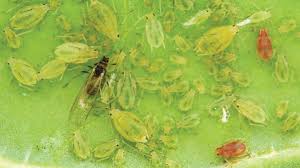
Effective Cultural and Biological Control Methods for Green Peach Aphids on Tomato
Many gardeners cultivate tomatoes as one of their favorite cultures, however, the green peach aphid (Myzus persicae) is one of the most constant and aggressive pests. Not only; these pests sucks the energy from the tomato plants, but they are also disease carriers which makes it even more complicated. This pest is considered one of the most dangerous for tomato crops therefore its management is a critical factor in achieving proper growth of the plant. This blog specifically looks at culture and biology methods towards controlling these pests and gives an overall non-chemical solution towards controlling these pests.
Cultural Control Methods
They include cultural control which in this case entails manipulation of the environment for propagation to discourage the breeding of aphids. Here are some effective strategies:
- Crop Rotation: Some of the cultural methods that can help in the control of green peach aphids are; Changing crops annually can affect the life cycle of green peach aphids. Do not succeed in the same place every year, it is advised not to plant tomatoes or any other solanaceous crops in a field.
- Reflective Mulches: One has to know that reflective mulches can help to repel aphids. The reflected light hampers the ways in which aphids detect host plants hence leading to disorientation.
- Intercropping: Inter-cropping with plants that are not suitable for aphid colonization can also assist decrease tomato plant account. For instance, using herbs like basil or marigold in plants can be used for repelling the pests naturally.
- Sanitation: Removing plant debris and weeds around the garden minimizes aphid habitat, reducing their populations.
- Water Management: Avoiding excessive nitrogen fertilization and maintaining proper irrigation practices can make plants less attractive to aphids.
Biological Control Methods
Biological control of green peach aphid on Novobac leverages natural predators and pathogens to manage aphid populations. Such an approach can be very efficient if it is incorporated as a part of an extensive pest control plan.
Beneficial Insects: The use of predators is among the efficient methods of controlling green peach aphids since they have natural enemies. The most effective are lady beetles, lacewings, and parasitic wasps Most of the useful insects are beneficial insects that could be employed to control pests. These privileged insects feed on aphids hence controlling the populations of these pests.
Beauveria bassiana: This entomopathogenic fungus is among the most lethal / potent biological control insects. Some commercial products such as Beveria WP have the Beauveria bassiana that makes contact with the aphids to cause their death.
Active Ingredient of Beveria WP: The chemical constituent that is found within Beveria WP is Beauveria bassiana, which is a form of fungus that is commonly used to target several types of pests.
Application: Beveria WP can be purchased in wettable powder which can conform easily to tomato plants.
It adheres to the plant surface, where it comes into contact with aphids, initiating infection and ultimately leading to their death. For more details about Beveria WP, visit Novobac.
Nematodes: Aphids can also be controlled by means of the so called ‘‘good’’ nematodes which are capable of infecting the soil stages of the pests. These worm-like organisms parasitize the eggs and destroy the larvae of aphids in the soil thus cutting off its generations.
The Management of the Cultural and Biological Pests
Combining cultural and biological control methods can enhance overall effectiveness. Here’s a practical approach::
- Early Detection and Monitoring: You should always check the tomato plants often to notice if there is an infestation of aphids in advance. This way the condition can be detected early and appropriate treatment taken.
- Introduce Beneficial Insects: Release lady beetles or lacewings when the aphids start to appear in the garden. Some of these predators can help to drastically cut down aphid populations within a short time.
- Apply Beauveria bassiana pesticide: They include Beveria WP based on Beauveria bassiana, which should be applied before the appearance of the first signs of parasitic activity or as a prophylactic. The target pests get affected by this biological insecticide, but plants and other organisms are not endangered.
- Maintain Plant Health: There are a lot of things that are affected in the plant so as you can see healthy plants can help fight off pests better than sickly plants. Water your tomatoes well, keep them adequately fed, but do not give them too much nitrogen.
Conclusion
This paper focuses on how to effectively control green peach aphids on tomatoes while at the same time using minimal chemicals. When cultural measures are combined with bio-control methods like using parasites and pathogens like beneficial insects and Beauveria bassiana-based products then practically the aphid problem can be managed to the benefit of the gardener and the garden as well.
There are Beauveria bassiana powder containing products that people who would wish to control aphids can use; for example Beveria WP. To learn more and to make the purchase, please go to the following link. If such strategies are to be combined they will assist not only in controlling aphids but also for encouraging sustainable gardening.
